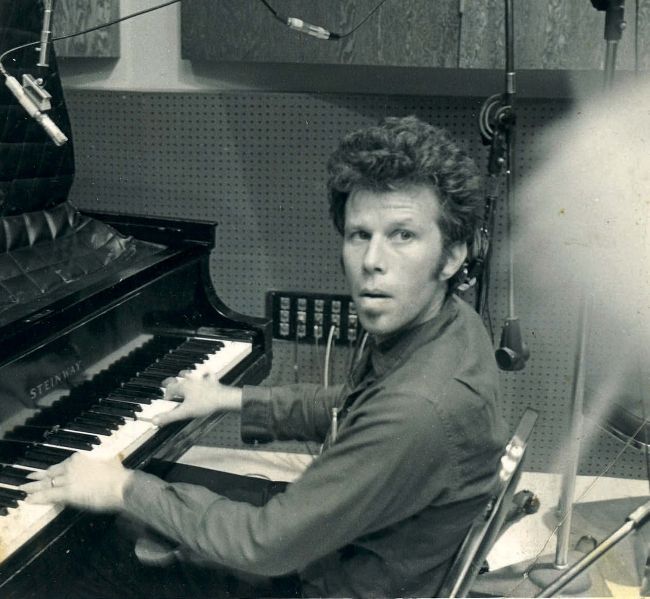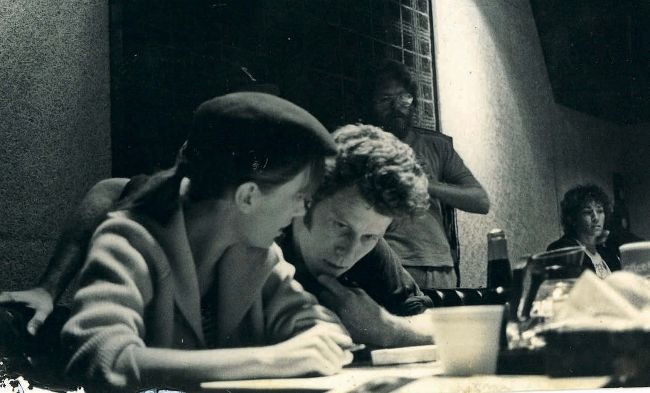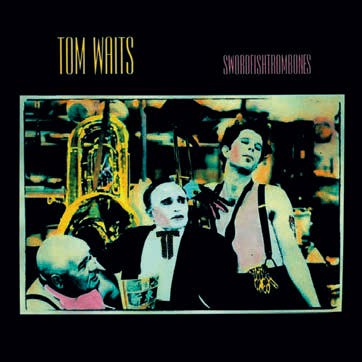TOM WAITS
WAY DOWN IN THE HOLE
It is the summer of 1982, and TOM WAITS is engaged in the dark arts of sonic derailment…

Waits recording Swordfishtrombones at Sunset Sound in Hollywood, 1982
CLARE O’CALLAGHAN
TRACKING his new album at Sunset Sound in Hollywood, for the smoky Hong Kong blues of “Shore Leave”, Waits records the sound of a metal chair being dragged across a linoleum floor and adds it to the mix. For another texture on the same song, he scatters rice on a bass drum placed flat, hits it hard and records the patter of the rice falling back onto the skin.
When B3 organ player Eric Bikales – at the time working with the rather more regimented Pointer Sisters – turns up to record his part for “Down, Down, Down”, he is given only one piece of direction. “I asked Tom if there was anything he was looking for on the B3,” says Bikales. “He put his hands up to his mouth, stretched them out in front of himself and said, ‘I need more…’ and made a long whooshing sound.” In the corner of the studio lurks a mysterious trombone player. “He was always there, but we hardly ever heard him!” says drummer Stephen Hodges. Throughout the sessions, there is a wholesale ban on cymbals. On certain songs, to give the drummer a hint of what he wants, Waits dances in front of him and gesticulates wildly with his hands.

Jersey girl: with wife Kathleen Brennan at Sunset Sound,1982
Welcome to the wonderful world of Tom Waits – 1980s style. With a new wife and creative partner, and myriad fresh artistic impulses to chase down, the one-time boho balladeer is in the throes of a thrilling and deeply unconventional artistic reinvention. The decade will take him from Los Angeles to New York, Edinburgh to Newcastle, Gothenburg to Chicago. He will star in arthouse films, collaborate with experimental theatre groups and jam with Keith Richards, but the lasting legacy of this period are three extraordinary albums: Swordfishtrombones, Rain Dogs and Franks Wild Years, a junkyard trilogy on which Waits dreamed up a brilliant, beautiful and at times disturbed collision of Kurt Weill, Weimar, Harry Partch, Captain Beefheart, New Orleans marching band, Irish folk, Italian tarantella, bone-shaking blues, Tin Pan Alley balladry, pre-war Caribbean rhythm and richly eccentric American storytelling.
Speaking to Uncut, Waits’ most trusted collaborators share the story of his most creative decade. “Tom was always allowed to put his artistic imprint on the lyric writing, but with Swordfishtrombones he wanted to create a musical sound that was more what he heard in his head,” says Waits’ friend and go-to bass player, Greg Cohen. “He wanted to change the type of instrumentation. He wanted to get away from the arranged feeling. He wanted to sound more earthy, with more rough edges.”
With these albums, Waits invented a new musical language. The product of an artist hellbent on pushing the extremes to their limits, throwing the sweet hard against the sour, they sounded like nothing else, before or since. Yet amid the clang and clatter and stomps and screams, at their heart is an exceptional songwriter at this peak. The songs he wrote are among the most beloved in Waits’ catalogue: “Time”, “Downtown Train”, “Shore Leave”, “Johnsburg, Illinois”, “Way Down In The Hole”, “In The Neighbourhood”, “Temptation”.

CLARE O’CALLAGHAN
“They were bulletproof,” says Michael Blair, Waits’ drummer and percussionist on Swordfishtrombones and Rain Dogs, and a member of his live band. “You couldn’t kill them! We could play stuff upside down and backwards and wrong, in that context, and Tom could pick what he wanted to use from that, and it always still sounded like the song, because they were just so well written. No matter what I did, no matter how weird it got, if I threw them down the stairs, the song still stood up. We got to box with and wrestle with the songs – because we saw Tom do that. He would wrestle with the feel, the characters, and the tone of his voice. It was really an intense process for him.”
“HE WANTED TO CHANGE THE TYPE OF INSTRUMENTATION”
GREG COHEN
BY 1982, Waits had long tired of the character cultivated during the 1970s, as well as its musical correlation – where every song he wrote was arranged instantly in his head for double bass, piano and drum kit, with lush strings on the ballads. “I’d nailed one foot to the floor and kept going in circles, making the same record,” he told Time Out in 1999.
Bassist Greg Cohen first worked with him on the tour promoting 1979’s Blue Valentine. “Tom was a bit more closed back then, but I learned who he was as an artist, and the myriad of strange influences this guy had,” says Cohen. “Not just literature, but fine art and nature and all sorts of things that he might not want everyone to know about. The more I learned about him, the more I could see where he wanted to move musically, to support his gift as a lyricist and his desire to do something other than what he had done before.”
Heartattack And Vine, released in 1980, had marked a shift of sorts. The growling guitar-heavy attack of the title track foreshadowed Swordfish… songs such as “Gin Soaked Boy”, but more radical surgery was required. “He’d been working for years with a team,” says Cohen. “He had a manager, Herb Cohen, a producer, Bones Howe, and guys that were arranging, Bob Alcivar or Jerry Yester. It worked for those records; the end result had a feel to it. But Tom felt the need to break away from that.”
The definitive catalyst was Kathleen Brennan. Born in Cork in 1955 and raised in Johnsburg, Illinois, Brennan was working as a script analyst for Zoetrope, Francis Ford Coppola’s production company. Waits and Brennan met while he was recording the soundtrack to Coppola’s One From The Heart. They married in 1980 – and everything changed. “When that [project] was finished, they just disappeared,” the late Bones Howe told Uncut in 2016. “I was never really able to make contact again.”